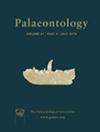Correction to ‘Ecological novelty at the start of the Cambrian and Ordovician radiations of echinoderms’
IF 2.3
2区 地球科学
Q1 PALEONTOLOGY
引用次数: 0
Abstract
Novack-Gottshall, P. M., Purcell, J., Sultan, A., Ranjha, I., Deline, B. and Sumrall, C. D. 2024. Palaeontology, 67, e12688.
Figure 6 should illustrate echinoderm phyloecospace through the Cambrian and Ordovician periods using the time-scaled UEH phylogeny number 49 as an example, but instead shows the alternative representation using the EAT topology (and phylogeny no. 57; see Fig. S6). This is the correct Figure 6:

FIG. 6
Open in figure viewerPowerPoint
Echinoderm phyloecospace through the Cambrian and Ordovician periods. Only the ecospace for the time-scaled UEH phylogeny number 49 is illustrated as one example; the remaining 49 time-scaled UEH phylogenies produce similar ordination structures. See Figure S6 for an alternative representation of ecospace using the EAT topology. Terreneuvian and Furongian epochs are plotted separately to the remaining Cambrian and Ordovician epochs to highlight changes occurring prior to diversification during the Cambrian and Ordovician radiations. First four principal coordinate (PCO) axes are illustrated, with each point representing some unique life habit, and colour-coded according to taxonomic class. The underlying time-scaled phylogeny represents the phylogenetic distribution of tip genera and ancestral nodes in the ecospace. The convex hull in each ordination is provided as a simple measure of overall ecospace occupied during each interval; the Terreneuvian and Furongian convex hulls are plotted as dashed lines in the subsequent temporal interval for comparison. Points are transparent to illustrate regions where multiple tips and ancestors overlap, with ancestral classes assigned when all descendants are assigned the same class, and with nodes illustrated as more transparent than tips. Taxonomic group ‘other’ includes the early blastoid Macurdablastus, coronate blastoid Mespilocystites, cyclocystoids, helicoplacoids, parablastoids, and taxa of uncertain class affiliation. The legend at bottom left illustrates the approximate positions of the four iconic ecological strategies mentioned in text. The first four axes account for 1.40, 0.40, 0.32, and 0.27% of explained relative eigenvalues in the 731-dimensional distance matrix. This figure is updated from Novack-Gottshall et al. (2022, fig. 2), which provides additional context.
We apologize for this error.
对 "寒武纪和奥陶纪棘皮动物辐射开始时的生态新奇性 "的更正
Novack-Gottshall, P. M., Purcell, J., Sultan, A., Ranjha, I., Deline, B. and Sumrall, C. D. 2024.图 6 应该以第 49 号 UEH 系统发生的时间尺度为例说明棘皮动物在寒武纪和奥陶纪的植物空间,但却显示了使用 EAT 拓扑(和第 57 号系统发生;见图 S6)的另一种表示方法。这才是正确的图 6:FIG. 6Open in figure viewerPowerPoint棘皮动物在寒武纪和奥陶纪的植物生态空间。仅以第 49 个时间标度的 UEH 系统发生的生态空间为例进行说明;其余 49 个时间标度的 UEH 系统发生也产生了类似的排序结构。使用 EAT 拓扑的另一种生态空间表示方法见图 S6。特雷努维纪和芙蓉纪与剩余的寒武纪和奥陶纪分开绘制,以突出寒武纪和奥陶纪辐射期间分化之前发生的变化。图中显示了前四个主坐标(PCO)轴,每个点都代表某种独特的生活习性,并根据分类学类别用不同颜色标注。底层的时间尺度系统发生代表了生态空间中尖端属和祖先节点的系统发生分布。每个排序中的凸壳是对每个时间间隔内整体生态空间占据情况的简单衡量;在随后的时间间隔内,特雷努维亚凸壳和芙蓉亚凸壳被绘制成虚线,以便比较。点是透明的,以说明多个顶端和祖先重叠的区域,当所有后代被分配到同一类别时,祖先类别也被分配到,节点比顶端更透明。其他 "分类群包括早期胀大藻类 Macurdablastus、冠状胀大藻类 Mespilocystites、环囊藻类、helicoplacoids、parablastoids 以及分类群归属不确定的类群。左下方的图例说明了文中提到的四种标志性生态策略的大致位置。前四条轴线分别占 731 维距离矩阵中相对特征值的 1.40%、0.40%、0.32% 和 0.27%。本图根据 Novack-Gottshall 等人(2022 年,图 2)更新。(2022,图 2)更新而来,它提供了更多的背景信息。我们对这一错误表示歉意。
本文章由计算机程序翻译,如有差异,请以英文原文为准。
求助全文
约1分钟内获得全文
求助全文
来源期刊

Palaeontology
地学-古生物学
CiteScore
5.60
自引率
3.80%
发文量
43
审稿时长
6 months
期刊介绍:
Palaeontology publishes a wide variety of papers on palaeontological topics covering:
palaeozoology
palaeobotany
systematic studies
palaeoecology
micropalaeontology
palaeobiogeography
functional morphology
stratigraphy
taxonomy
taphonomy
palaeoenvironmental reconstruction
palaeoclimate analysis and biomineralization studies.
 求助内容:
求助内容: 应助结果提醒方式:
应助结果提醒方式:


